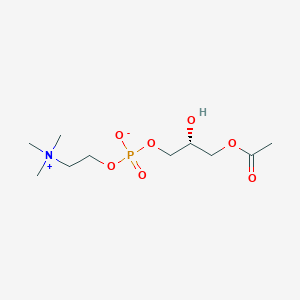Possible associated with:
| Structure | name | description | Reference count |
|---|---|---|---|

|
DHA | Dha is a lipid of Fatty Acyls (FA) class. Dha is associated with abnormalities such as Atherosclerosis, Consumption-archaic term for TB, Chronic disease, Cardiovascular Diseases and Diabetes Mellitus, Non-Insulin-Dependent. The involved functions are known as Inflammation, Oxidation, fatty acid oxidation, Fatty Acid Metabolism and Lipid Metabolism. Dha often locates in Hepatic, Protoplasm, Mucous Membrane, Epithelium and outer membrane. The associated genes with DHA are IMPACT gene, FATE1 gene, GAPDH gene, THOC4 gene and SLC33A1 gene. The related lipids are stearidonic acid, Fatty Acids, Total cholesterol, Lipopolysaccharides and Dietary Fatty Acid. The related experimental models are Mouse Model, Transgenic Model, Animal Disease Models and Arthritis, Experimental. | 11054 |

|
7-octadecynoic acid | 7-octadecynoic acid is a lipid of Fatty Acyls (FA) class. | 8379 |

|
PGD2 | Pgd2 is a lipid of Fatty Acyls (FA) class. Pgd2 is associated with abnormalities such as Inflammatory disorder, Pleurisy, Rhinitis, Dehydration and Pneumonia. The involved functions are known as antagonists, fat cell differentiation, Phosphorylation, Process and Gene Expression. Pgd2 often locates in Cell surface, Body tissue, Extracellular, Bone Marrow and Membrane. The associated genes with PGD2 are oxytocin, 1-desamino-(O-Et-Tyr)(2)-, P4HTM gene, PTGS2 gene, PTGDS gene and IL3 gene. The related lipids are 15-deoxyprostaglandin J2, Nonesterified Fatty Acids, Lipopolysaccharides, Steroids and Liposomes. The related experimental models are Knock-out and Rodent Model. | 6464 |

|
Lysophosphatidylcholine | Lysophosphatidylcholine is a lipid of Glycerophospholipids (GP) class. Lysophosphatidylcholine is associated with abnormalities such as Ischemia, Obesity, Diabetes Mellitus, Non-Insulin-Dependent, Fatty Liver and Atherosclerosis. The involved functions are known as Inflammation, antagonists, Signal Transduction, Signal Pathways and Saturated. Lysophosphatidylcholine often locates in Body tissue, Head, integral to membrane, Membrane and Extracellular. The associated genes with Lysophosphatidylcholine are RHOA gene, Homologous Gene, GPR4 gene, GPR68 gene and TRPV2 gene. The related lipids are Nonesterified Fatty Acids, lysophosphatidylethanolamine, Lysophosphatidylcholines, Phosphatidylserines and 25-hydroxycholesterol. The related experimental models are Knock-out and Disease model. | 4395 |

|
1-Oleoyl Lysophosphatidic Acid | 1-Oleoyl Lysophosphatidic Acid is a lipid of Glycerophospholipids (GP) class. 1-oleoyl lysophosphatidic acid is associated with abnormalities such as Myocardial Infarction, early pregnancy, Scleroderma, Blind Vision and Hyperlipidemia. The involved functions are known as Agent, Blood coagulation, Selection, Genetic, Analyte and Biological Processes. 1-oleoyl lysophosphatidic acid often locates in Tissue specimen, Body tissue, Blood, Membrane and Skin. The associated genes with 1-Oleoyl Lysophosphatidic Acid are Mucin-16, Peptides, SMAD4 gene, RND1 gene and Polypeptides. The related lipids are lysophosphatidic acid, A(2)C, Lysophospholipids, Fatty Acids and sphingosine 1-phosphate. The related experimental models are Mouse Model, Knock-out, Cancer Model, Xenograft Model and Arthritis, Adjuvant-Induced. | 3463 |

|
lysophosphatidic acid | lysophosphatidic acid is a lipid of Glycerophospholipids (GP) class. Lysophosphatidic acid is associated with abnormalities such as Atherosclerosis, Alzheimer's Disease, Asthma, Diabetes Mellitus, Non-Insulin-Dependent and Septicemia. The involved functions are known as Inflammation, Chemotaxis, Binding (Molecular Function), Polymerization and Inflammatory Response. Lysophosphatidic acid often locates in Cytoskeleton, Microfilaments, actin cytoskeleton, Extracellular and Structure of germinal center of lymph node. The associated genes with lysophosphatidic acid are TNF gene, MAPK3 gene, RHOA gene, CDC42 gene and ADRBK1 gene. The related lipids are lysophosphatidic acid, Lipopolysaccharides, Lysophosphatidylcholines, Lysophospholipids and Phosphatidic Acid. The related experimental models are Knock-out, Transgenic Model, Rodent Model and Disease model. | 820 |

|
clarithromycin | clarithromycin is a lipid of Polyketides (PK) class. Clarithromycin is associated with abnormalities such as Helicobacter Pylori Infection, Infection, Coinfection, Gastritis and Peptic Ulcer. The involved functions are known as Point Mutation, Increased Sensitivy, Bacterial resistance, urease activity and Mutation. Clarithromycin often locates in Blood, Gastric mucosa, Biopsy sample, Respiratory System and Entire gastrointestinal tract. The associated genes with clarithromycin are Genes, rRNA, rRNA Operon, Genome, HM13 gene and GDF15 gene. The related lipids are 9,11-linoleic acid, Steroids, Lysophosphatidylcholines, Lipopolysaccharides and 4-hydroxycholesterol. The related experimental models are Mouse Model, Knock-out and Experimental Pneumococcal Meningitis. | 10449 |
Total
7